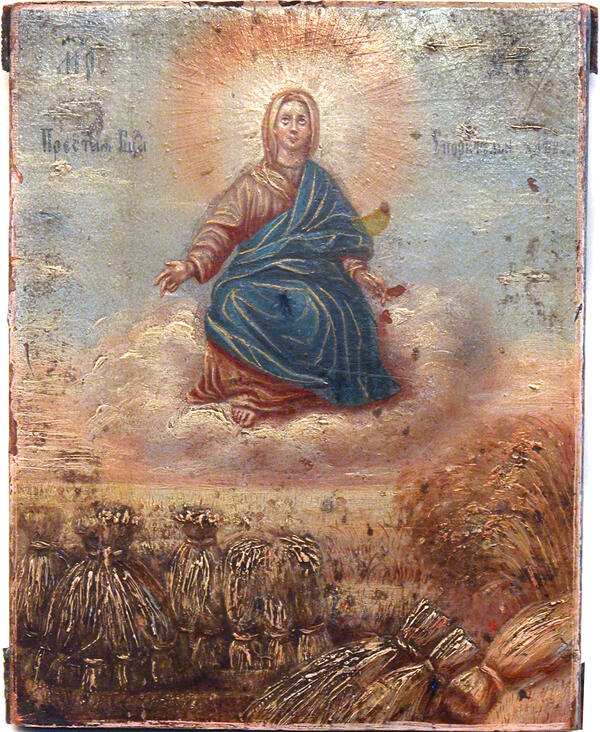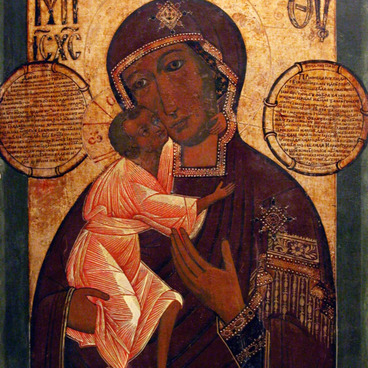Orthodox iconography numbers more than 250 images of Mother of God. The general canonical images were based on the Byzantine and early Roman examples. Many of the plots for Mother of God’s images were based on the historical facts of her image’s appearance at certain places.
However, this icon is a rare example of a ‘commissioned’ image of the Mother of God. The image of the Mother of God Bread Sporitelnitsa appeared quite late, after 1891. The bread appeared as a plot not accidentally: in 1891 an incredibly bad harvest, which hit the Central Russia the most, took place.
That year was also very difficult for the Convent of St. Ambrose and Our Lady of Kazan, situated not far from the Optina Pustyn. Reverend Ambrose Optinsky prayed to the Mother of God for the starving time to finish. At the time the idea to create an icon depicting the Mother of God, praying for the land fertility, appeared. The icon was painted at the monastery. Some sources say it was made by hieromonach Daniil (Bolotov), brother of Sofia, the Mother Superior of Convent of St. Ambrose and Our Lady of Kazan. He liked academic painting, which is clearly seen from the picture.
This Mother of God’s iconography is special, there were no such images in the Orthodox icon painting. It is shown barefooted sitting on the cloud above the sheaves of wheat. The Mother of God is shown passing the people God’s mercy via her open palm and not with the sigh of the cross, which was traditional.
Surprisingly, 1892 was an extremely fruitful year for the Convent and surrounding areas, while the hunger continued in other regions. The copies of the icon were sent there. The icon pleased the peasants’ souls and always reminded them of miracle and God’s presence. The veneration of Mother of God’s image as a saint patron was widespread, as the peasants’ life always depended on a full-year cycle. The church holidays were connected with seeding, harvest and preparing the ploughland.
The history of the icon was complicated. The Synod banned it one year after its creation, that’s why there aren’t as many of its copies as the ones of the old wonderworking icons. Iconography was criticized for its lack of canon and reference to the pagan beliefs, where the cults of Mother Land and Mother of Bread were popular. Ambrose’s personality was also ambiguous in the church world.
A few icons with the same title dated after 1890 are now in the collection of The State Tretyakov Gallery and The Andrey Rublev Museum. And one of the examples of late academic painting, which belonged to the unknown Trans-Uralian peasant, is now in the collection of the Kurgan Regional Art Museum.
However, this icon is a rare example of a ‘commissioned’ image of the Mother of God. The image of the Mother of God Bread Sporitelnitsa appeared quite late, after 1891. The bread appeared as a plot not accidentally: in 1891 an incredibly bad harvest, which hit the Central Russia the most, took place.
That year was also very difficult for the Convent of St. Ambrose and Our Lady of Kazan, situated not far from the Optina Pustyn. Reverend Ambrose Optinsky prayed to the Mother of God for the starving time to finish. At the time the idea to create an icon depicting the Mother of God, praying for the land fertility, appeared. The icon was painted at the monastery. Some sources say it was made by hieromonach Daniil (Bolotov), brother of Sofia, the Mother Superior of Convent of St. Ambrose and Our Lady of Kazan. He liked academic painting, which is clearly seen from the picture.
This Mother of God’s iconography is special, there were no such images in the Orthodox icon painting. It is shown barefooted sitting on the cloud above the sheaves of wheat. The Mother of God is shown passing the people God’s mercy via her open palm and not with the sigh of the cross, which was traditional.
Surprisingly, 1892 was an extremely fruitful year for the Convent and surrounding areas, while the hunger continued in other regions. The copies of the icon were sent there. The icon pleased the peasants’ souls and always reminded them of miracle and God’s presence. The veneration of Mother of God’s image as a saint patron was widespread, as the peasants’ life always depended on a full-year cycle. The church holidays were connected with seeding, harvest and preparing the ploughland.
The history of the icon was complicated. The Synod banned it one year after its creation, that’s why there aren’t as many of its copies as the ones of the old wonderworking icons. Iconography was criticized for its lack of canon and reference to the pagan beliefs, where the cults of Mother Land and Mother of Bread were popular. Ambrose’s personality was also ambiguous in the church world.
A few icons with the same title dated after 1890 are now in the collection of The State Tretyakov Gallery and The Andrey Rublev Museum. And one of the examples of late academic painting, which belonged to the unknown Trans-Uralian peasant, is now in the collection of the Kurgan Regional Art Museum.



